

CHLATEOCO Checker &

EDITORIAL
DEAR READERS,
You are now about to embrace an exciting journey through our sisterMAG issue 66 - the first for the new year. And while we are at it, this is not just a new issue for me. It is a pretty special moment simply because sisterMAG issue 66, Checker & Chocolate, happens to be my first as part of the team. Pretty thrilling, right?
For Checker & Chocolate, we draw inspiration from colors, crafts, and what is in our blood - DIY. Those who have been around for a long time, I am sure, already know - Evi‘s creativity knows no boundaries. Between the pages of our new issue, you are about to find her latest collection of sewing patterns - Shades of Chocolate - inspired by the various shades and forms of the sweetest temptation in this worldchocolate. Chick and timeless, they can already be found in our online shop.
Viktoria
And the checkered pattern... Being around for centuries, it not only managed to become a fashion stable but, with the help of fashion visionaries such as Vivienne Westwood, the checkered pattern changed pop culture. In a magazine issue dedicated to it, there was hardly any more suitable place for our traditional DIY tour than the home of the tartan pattern country of Scotland. Join the sisterMAG team and Shawna Law on our stroll through Edinburgh‘s DIY shops. We are sure it would bring you as much joy as it did to us. And because crafts are the language we speak best, quilting and patchwork are the techniques sisterMAG issue 66 explores. Moreover, we have an exciting tutorial from Ania Grzeszek (@kaliko_co) for your very own DIY patchwork bag. Let your imagination run free and start your next DIY project.
& the sisterMAG Team
TABLE OF CONTENTSsisterMag 66
CHECKER & CHOCOLATE
56

My Sewing Story …with Martha Blusen 12
The History of Checkered Patterns
From its first appearances to Vivienne Westwood 20 Our favourite new Neutral: Brown The comeback of a color as versatile as ever 26
Shades of Chocolate
sisterMAG Patterns Fashion Collection with DIY Sewing Patterns 66
Our collection on Instagram
We show you how the sisterMAG Patterns Community interprets the new patterns
The Bar of Chocolate
How the chocolate bar was developed 64 The History of Patchwork & Quilting
Passed down from generation to generation 72
Patchwork in the world of Instagram
The most creative ideas around patchwork 76
Our exclusive sisterMAG Patterns Patchwork Dress
An elegant silhouette meets a patchwork cottage hem

80

DIY Tour Edinburgh
Shawna Law takes us to her home city and shows insider tips for all DIY maniacs in the Scottish capital 96
DIY Patchwork Bag
A geometric jewel from Kaliko 106
DIY Patchwork Wall Decor A simple idea for any frame or space with 3D effect 108
Patchwork Books & Ressources
For further reading and an almost infinite number of projects
OUTFIT







Patchwork


Many thanks to the whole team who created our beautiful fashion line and the new cover. Of course you can find the outfit of our cover as a new pattern in the @sistermagpatterns online Shop.

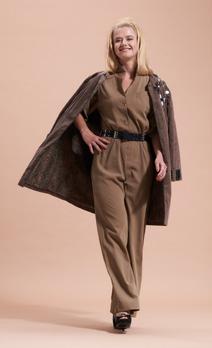



Today we introduce you to Stefanie from „Martha Blusen“ in our series „My sewing story“ . She discovered the passion for sewing at a young age and turned her passion into a profession with „Martha Blusen“. Each of her garments is a unique piece with special attention to detail. Get to know Stefanie better in our portrait.
OneWhat was your first experience of sewing? Do you come from a family of tailors?
Crafts have been a hobby since I was young, mostly knitting and sewing. In the mid-sixties, handicrafts were still taught at school – my favorite subject!
When it comes to sewing, I was mostly influenced by my mother. She’s not a trained seamstress, taught herself and made beautiful pieces for herself, my sister and me. A huge inspiration!
Two
When did you start sewing? Did you teach yourself to sew, or did you attend a course?
I properly started sewing when I began my training as a women’s tailor.
Three
What was the first piece that you made yourself? To be honest, it’s nothing special – the lining for a skirt – because during your training you have to learn everything. Every bit has to be accurate and precise and you’re doing many background tasks. This didn’t make it less fun for me, on the contrary: I got even more interested in great patterns, beautiful fabrics and colours and patterns fascinate me. Every beautifully made piece makes me happy because I feel like I’ve accomplished something.
Four

How did Martha Blusen come to be founded?
When we started our family, I stayed home with the kids and, for personal reasons, decided to re-train as medical personnel at a doctor’s office ten years ago. A friend of mine kept complimenting me on the pieces I made at home and motivated me to do more with them. That’s how “Martha Blusen“ got started.
special?

Every piece is unique, with lots of love in every detail.
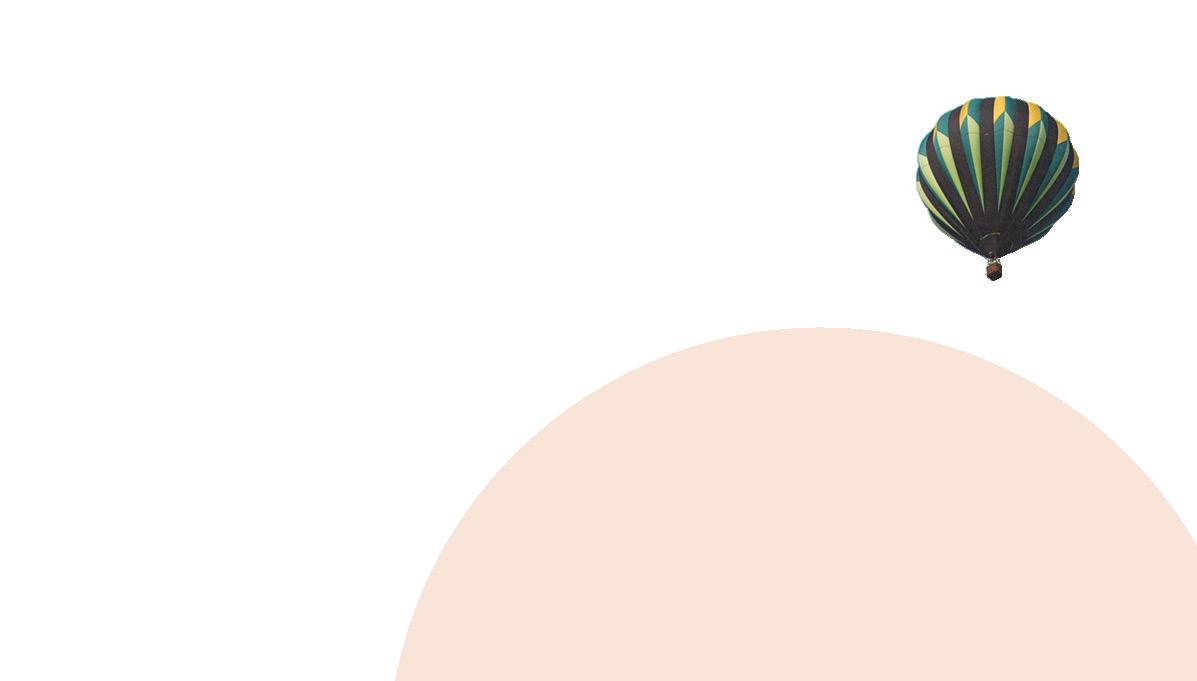
I like working with high-quality fabrics, usually good cotton (e.g. from Liberty) or viscose. Together with my customers, I pick the fit, neckline, a refined collar and the matching sleeves. Added borders are an eye-catcher. All of this makes my blouses what they are, and I enjoy making unique creations. I also love changing up existing clothes, such as turning the favourite shirt of the husband into the wife’s new blouse – upcycling.
I am inspired by interesting people in town or cafés and restaurants. Many of my ideas also come from Instagram. It’s so interesting how many different fabrics and patterns I can find there. It’s great fun to discover new things.
Five What makes a Martha blouse
You would like to tell us your story and how you started your handicraft? Write us an email at mail@sister-mag.com





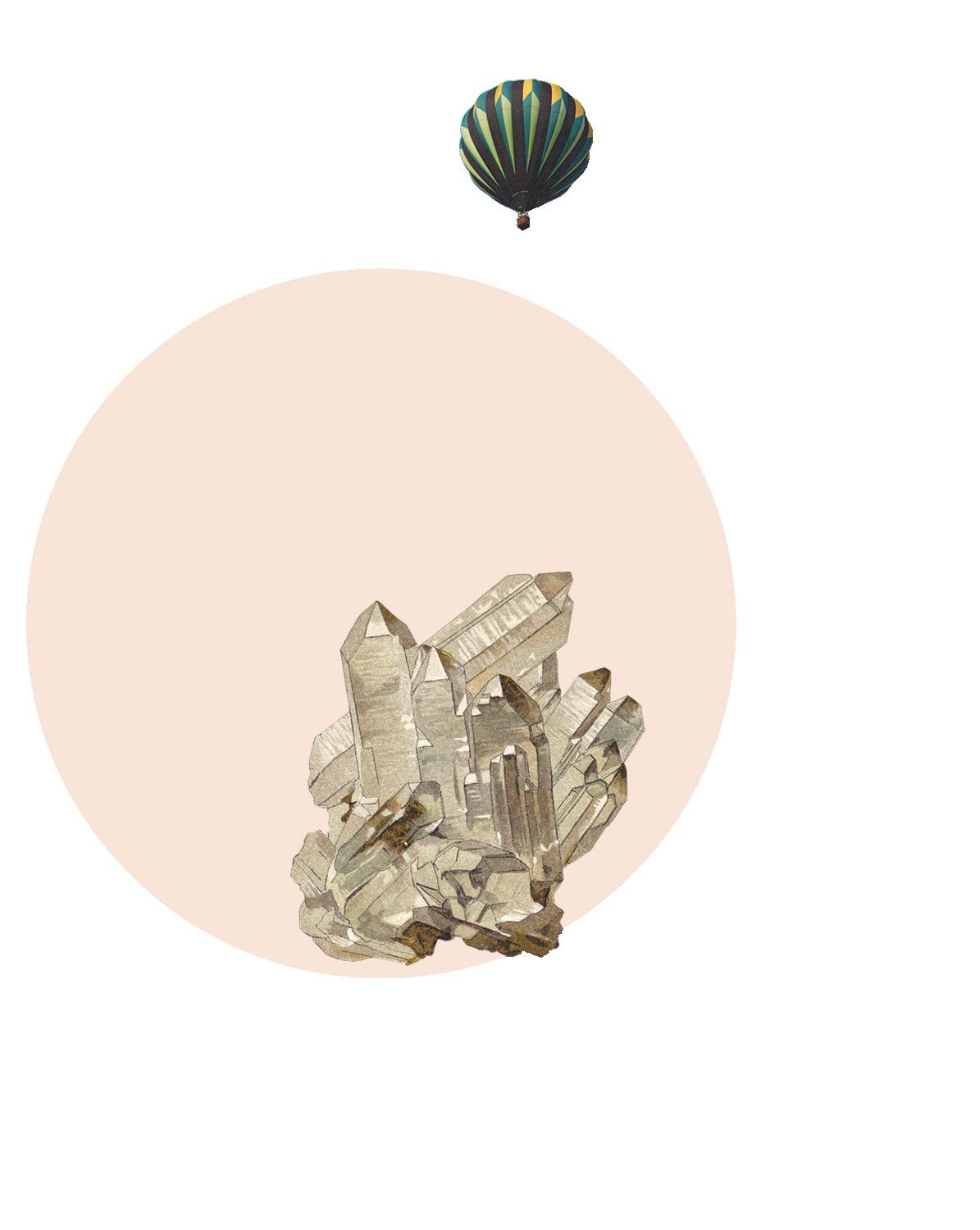
The history of

 ©
Vivienne Westwood
©
Vivienne Westwood
The checkered print and its many timeless variations have been taking the runways by storm — but that’s nothing new. While many new trendy aesthetics and iconic designers have spun their takes on the prints, checkered patterns have a much deeper history. They’ve been around for centuries and have taken so many different forms throughout time — and while these prints may seem classic and simple, their variations have represented deep emotional and ideological ties to masses of different groups. This article will only scratch the surface of the vast history of different patterns belonging to cultures and groups, but we hope to give an image showing the impact of the checkered patterns going much deeper than the current TikTok and runway trends.
PATTERNS



TAN

TARTAN IN SCOTLAND
In the 16th century came the popularization of Scottish tartans for different family names, using distinct plaid patterns and colors to define what region or family people belonged to. However, tartans can actually be dated back to the third and fourth centuries in Scotland. This handwoven cloth was so incorporated in Scottish culture that after the Battle of Culloden in 1746, the British actually banned tartans in an attempt to control the Scottish people. This is actually how the patterns became standardized and identifiable with each clan name because there was a primary manufacturer who began mass producing tartans, by the name of William Wilson & Sons of Bannockburn. They named the prints by local names, streets, and family names without
intention for them to become the family symbols they would. It was the aims for Highland culture preservation coupled with rumors of Scottish clan tartans in England that partially helped to create this identification and connection. Clan chiefs were being asked what their clan tartan was, and so they adopted or created theirs.
SOCIAL CULTURE WAVES
Throughout time, the various checkered patterns have been associated with many political affiliations and different cultures. While they come up in so many trend waves, they have much deeper meanings for a lot of people. Similarly, in terms of the runway, checkered patterns have always held a strong place and served as symbols of different social culture movements.

PUNK CULTURE
Vivienne Westwood , well-known British designer, essentially founded tartan patterns as a symbol of punk culture to counteract the traditionally royal place the tartan print held in England. She styled the Sex Pistols in tartan, who helped instill tartan as a widespread aesthetic through the punk scene. She used tartan to make new, incredibly unique silhouettes that shook the fashion world.
 Burmese Man, 1890s
Burmese Man, 1890s
Vivienne came to be one of the most iconic designers of her time due to the way her designs challenged current trends and backed social movements of rebellion.

CHECKERBOARD AND SKA
Checkerboard print symbolized a fight against segregation after being claimed by second wave Ska artists and their listeners in the 1970s . Ska, a two-toned music, was born in Jamaica. Its second wave took over England and its multiracial collaboration was instrumental in representing racial rights. They used checkerboard print as a symbol to show both black and white musicians coming together.
CHECKERBOARD AND SKATING

Additionally, checkerboard Vans became a widely known symbol of skate culture. In 1977 , after seeing skaters draw checkerboard on the top of their shoes, Vans released the classic checkerboard slip-on shoe. These exploded through the skating community and became a stark signifier of punk and skate culture, and they were also sported by bands and in films.



DESIGNER IMPACT
We’ve seen designers like Burberry make tartan a distinct signal of their brand since the 1920s , loved by many walks of life from business people to celebrities. In the past couple seasons, designers like Dior , Gucci , and Chanel have featured checkered print matching sets and nuanced silhouettes in their collections. But it doesn’t end here; these new takes show just how the fashion industry continues to use these classic prints and transform them into new and exciting forms.

VARIATION

Checkered prints have also taken other forms and variations such as gingham , shepherd , windowpane , buffalo , and more, which allow for much versatility. These different checkered patterns are of course timeless, but inevitably fall into trendy aesthetics like “dark academia” and “cottage core” which target a younger audience due to the fact that they circulate primarily on TikTok. However, checkered patterns are also popular among other generations in casual and more professional attire. They fit every season, color palette, and occasion.
That being said, these are very few examples of the cultures and groups of people who have used variations of checkered patterns as a symbol of their community or cause. We are going into this issue of sisterMAG offering a glance into checkered patterns through the lens of the runway — which credits its existence to all of the people and groups who invented and closely held these patterns in the past. We hope you love the latest creations as much as we do!

You don’t have to look far to spot a brown item in 2023 fashion trends and runway styles. There’s no doubt that brown is having a big moment in fashion right now, and for our Checker and Chocolate issue, we knew we had to take a closer look at this hue!

So what exactly is so special about this shade? From a color theory standpoint, brown is unique because it can be mixed from so many different color combinations, which is why this neutral matches well with a variety of other colors. Browns encompass a huge swath of shades and tones; everything from very light camel and khaki to deep espresso and umber. These shades include both warm and cool undertones, meaning that there’s a shade of brown perfectly suited to every skin tone.
Psychologically, brown instills a sense of calm and comfort due to its muted quality, which does not overwhelm the eye. We see brown everywhere in nature – tree bark, dirt, stems – making it a natural, grounded color that feels reliable and solid. Eve Ashcraft, a color consultant, notes that “There’s a kind of back-to-basics aspect of brown. It’s like the comfort food of color.”
While brown may be the comfort food of color, the other more sophisticated side to brown can also be seen through food comparisons, like our featured food itself – chocolate ! Rich desserts like mousse, molten lava cake, and dark chocolate fudge reveal the indulgent, sophisticated, and chic side to brown, especially when worn in its darker shades. Vogue Fashion recommends juxtaposing the color’s ruggedness with its sophistication; you can implement “the earthy color as a way to contrast sexy silhouettes or ground feminine pieces, resulting in an understated elegance hard to achieve with any other hue.”
Despite all of its merits as a calming neutral with a variety of shades, brown has only recently regained its standing as a popular neutral . Brown last took the spotlight in the 1970s in combination with green and orange, but in recent years, fashion has favored other neutrals like black and white. Despite brown’s hiatus in fashion, increasing appreciation of nature could help explain its return. Now, in the 2020s just as in the 1970s, sustainability and conservation of the earth is a major priority of the upcoming generation. As people increasingly seek to protect nature, fashion too may reflect a greater appreciation for the beauty of the outdoors.

If we haven’t sold you yet on our new favorite neutral, here are some ways to incorporate brown into your existing wardrobe:
Chances are, you may already own brown accessories. Some of our favorites include tall camel boots, a caramel leather jacket, or a mocha mini bag. Accessories are a great way to get started wearing brown.

If you’re already a brown fan, take your outfits to the next level by mixing and matching different shades of browns . Because of the extensive variety of shades and tones, the possibilities for brown combinations are endless.
Fall & winter is the perfect time to start incorporating brown into your closet ; as the leaves start changing, warm browns match the fall aesthetic perfectly. And when it gets colder and grey, it adds a warm hue to our wardrobe. Our favorite winter prints are checkers of course ! Opt for a brown tartan scarf or a cozy argyle sweater. Plaid and houndstooth suits and jackets will help you stay warm while also looking chic. You can even double up on different types of checkered patterns to add interest to your outfit.
Fall-Winter2020 VivienneHuEarth: reliability, solid Warmth, comfort: natural and down to earth
Solitude: sophistication, depth
Most colors can create brown, which is what makes it go with so many colors.
Brands use it to create a wholesome, natural, rugged image (but also think of indulgent, sophisticated, smooth chocolate companies)
Brown is having a renaissance. From deep chocolate to buttery toffee, brunette hues have returned from fashion exile to become one of the most sought-after shades of the year. Long considered dated, dull, and unsophisticated — especially when compared to fellow neutrals like black, white, and grey — the color seems to have rehabilitated its public image and emerged as a mainstay in the homes and wardrobes of celebrities, models, designers, and influencers. Even Gen Z is on board. Current appetite for minimalism, sustainability, and natural beauty .

“It’s not bling. It’s not fancy. It’s accessible. Who can’t find something brown?” says Eve Ashcraft, a renowned color expert who famously helped Martha Stewart develop her inaugural paint collection based on the bluish-green hues of her chickens’ eggs.
Still, throughout history, the dark neutral has been used to symbolize modesty and simplicity , with members of the working class wearing plain clothes in browns and beiges, while nobles and aristocrats sported extravagant garments in deep blues, purples, and reds. In ancient Rome, the term for plebeians, or the urban poor, was “pullati” which literally translates to “those dressed in brown.” In the Middle Ages, Franciscan monks donned espresso-colored robes as a tangible symbol of their vow of poverty.
This has some precedent. Preference for earthy neutrals emerged from the shadows in the ’70s, as the hippie movement spawned widespread concern about the environment. The growing interest in conservation — coupled with a general rejection of materialism and consumerism — was reflected in many homes and
closets at the time. Many kitchens featured an ochre and brown color palette combined with lots of natural woods and stones, while cinnamon-colored blouses and auburn leather knee-high boots were considered wardrobe staples.
Used the earthy color as a way to contrast sexy silhouettes or ground feminine pieces, resulting in an understated elegance hard to achieve with any other hue.
Given the current penchant for minimalism and natural beauty, it makes sense that this natural tone has been embraced on runways and in street style alike. From deep chocolate to light sand, the entire spectrum of brown is on trend.


SEWING PATTERNS BY SISTERMAG PATTERNS
of CHOATECOL Shades
Apparently, there are over 700 kinds of beans –white, yellow and green, every variety, but truly I only liked one: the cognac bean. In this issue we show you clothes and outfits inspired by chocolate varieties, because chocolate can be so versatile! And so is our fashion.










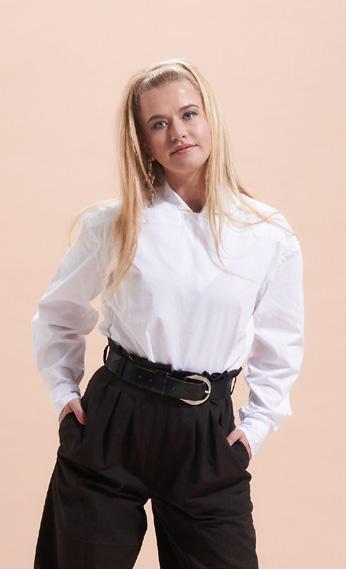







SIZES 34-50 (EU) | 4-20 (US)
16-4
Cropped blouse with shawl collar and cuffs & 50-1 Jersey skirt

Chocolate with nuts should rather be called ‘chocolate refined with nuts’, since it’s not the chocolate that contains the healthy, unsaturated fatty acids, but the nut itself. And they’re what keep our brains going.
16-4 cropped blouse with shawl collar and cuffs & 50-1 jersey skirt
A cropped, belly-revealing blouse was missing in our collection and so we took the one we made for sisterMAG Nr. 16 and revamped it a little. Combined with the jersey skirt 50-1 in a thick, roughened jersey with shoulder pads and patch pockets, this is an ensemble for stylish looks on colder days.



Truffles – A collection of truffles could almost be compared to us humans. They come in every shape. Pure chocolate, filled with nuts, styled with aromatics, naked or wrapped in silver paper, brown, white, with nougat or brittle – they’re all enchanting but beware of the dreaded empty ones!

SIZES 34-50 (EU) | 4-20 (US)
57-4 oversized jumpsuit with lapel collar & 4-3 boule-coat with embroidery and piping
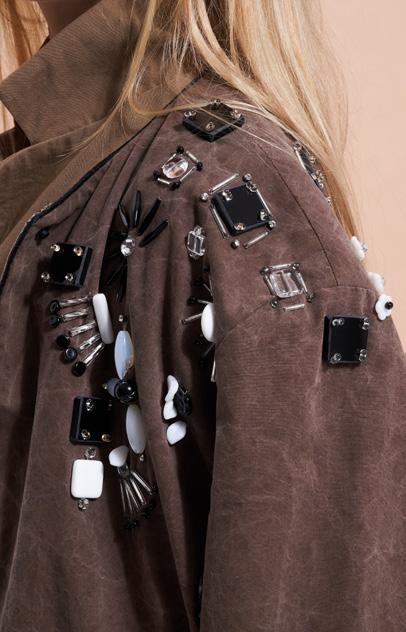
Don’t we all love a good jumpsuit? This one is particularly comfortable. An exciting lapel collar decorates the neckline and the front features a row of 3 buttons. Worn with a belt around the waist, this is an eye-catching piece. We chose a boule-coat to wear over the top. The pattern comes with different options for beautiful embroideries so everyone can decorate it to their heart’s content.

SIZES 34-50 (EU) | 4-20 (US)
66-4 Camping blouse in 2 variants & 41-3 Paperbag trousers
The so-called Herrenschokolade mit Sahne (literally translated: men’s chocolate with cream) also goes by the name of „mild dark chocolate“ , as if a female hand strokes across the rough beard of a sailor.
66-4 camping shirt in 2 varieties & 41-3 Paperbag trousers
The classic button-down shirt is a staple in every closet, including different collar shapes. Oversized shoulders and an unusual collar feature on our new camping shirt. The long-sleeved version goes well with the elegant 41-3 Paperbag trousers, completing our ‘Herrenschokolade mit Sahne’ outfit.





SIZES 34-50 (EU) | 4-20 (US)
66-1
Mini skirt with pleats and 4 pockets
Dark milk chocolate , that means 70, 50, 30% cocoa solids, with lots, medium and little magnesium – lots of energy for the heart or sadly rather little! But our little skirt will certainly give you a lot of energy:
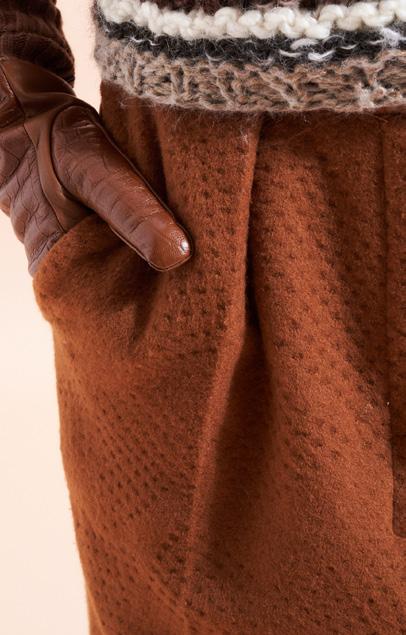

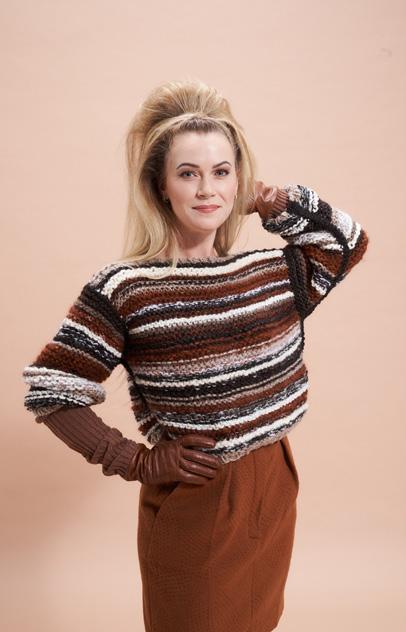
66-1 mini skirt with pleats and four pockets
A classic pattern for an elegant and modern outfit. This beautiful skirt is short and has an elegant shape thanks to its pleats. And it has lots of pockets because we simply love those!
SIZES 34-50 (EU) | 4-20 (US)
32-4 Fluffy patchwork jacket & 66-4 Camping blouse in 2 variants & 50-6 Slim stirrup trousers with elastic foot loops

After Eight - works for every amorous tête-a-tête: its masculine, high cocoa content is smoothed out by a soft, feminine sugar mass decorated by the typical peppermint flavour – pure seduction – small – flat – square – delicious!
32-4 fluffy patchwork jacket & 66-4 camping shirt in 2 variants & 50-6 Slim stirrup trousers with elastic foot loops
Our patchwork jacket without patchwork but made from fluffy faux fur. We combined it with the slim, comfortable tapered trousers with elastics for the feet that prevent it slipping up the leg. They’re a high-quality leggings substitute! This outfit is made for cosy winter hours spent together.




SIZES 34-50 (EU) | 4-20 (US)
66-3 Slightly flared skirt with decorative flaps & 66-4 Camping blouse in 2 Variants
Mocca beans - the sibling of the cognac bean. Both are explosions of flavour hidden under innocent chocolate covers. What a glorious idea, firstly for the day, the bigger and more dangerous variety for late hours. Who could resist?
66-3 A-line skirt with decorative flaps & 66-4 camping shirt in 2 varieties


This beautiful A-line ladies’ skirt is shown with our camping shirt, this time without sleeves. The skirt is finished by two buttons and a wide waistband, the flaps adding a certain je ne sais quoi. Play with fabrics and lengths, this skirt can be worn in many ways.

SIZES 34-50 (EU) | 4-20 (US)
66-5 Off-the-shoulder Carmen blouse
66-5 Off-the-shoulder Carmen blouse
Thanks to Maria Grazia Chiuri, we’re seeing a revival of the off-shoulder blouse in women’s fashion – romantic versions with ruffles and not a hint of hippie vibe. Off-the-shoulder is in and the shoulder is shown in the right light, no matter whether it’s summer or winter. Elegant versions made from silk and taffeta are made for parties, fine cottons or linens for casual days or the office. This blouse can be worn with trousers, jeans and skirts. SHOP NOW





SIZES 34-50 (EU) | 4-20 (US)
23-6 Costume jacket in 2 variants & 65-4 Wide shorts with cut waistband
Chocolate from Modica - made with a Spanish recipe –the cocoa beans aren’t roasted but ground, spiked with aromatics instead of conched. You may wonder about the grainy, raw texture. Something special from Sicily, Italy!
23-6 Costume jacket in 2 variants & 65-4 Wide shorts with cut waistband

Everyone who has been sewing for a long time will have a pattern for a blazer in their archive that may not be very modern but just fits. This was the case for our blazer from sisterMAG 23: The long blazer is still chic and an updated short version with mixed patterns and a few adaptations makes it fashionable. The wide shorts in a matching fabric make for a stunning two-piece suit that will be your favourite new outfit.


SIZES 34-50 (EU) | 4-20 (US)
37-2 A-line dress with bow in the back
Chocolate and vanilla – this one can be expensive! Making chocolate is already a complicated process – roasting – grinding –conching, and hand-raising the proud orchid that produces „Vanilla“, the queen of spices, is just the same.
37-2 A-line dress with bow Who still remembers our 37-2 A-line dress with a bow? We re-made one of your favourites into a fall-and-winter appropriate version. Long sleeves and thick fabric make this piece last long. It’s not necessary to put this piece away after summer.


SHOP NOW



SIZES 34-50 (EU) | 4-20 (US)
16-6 Sleeveless dress withpleated skirt and leather details

Pistachio chocolate – those of you who would like their brown gold to be even more aromatic and sweet, who are looking for a touch of almond and marzipan in their chocolate, will love pistachio chocolate, often presented in a green outfit because only green pistachios are good.
16-6 Sleeveless dress with pleated skirt and leather details
This elegant dress features a sleeveless top with collar, stitching and leather details. The pleated skirt has a playful edge and perfectly matches the straight lines of the top. A long zipper in the back makes for easy dressing. The leather shoulder flaps give off a modern military vibe.


We went on a search in our sewing community and found product testers who tried out our various garments from our pattern shop range and interpreted them in their own way. See the beautiful results here!

#SISTERMAGPATTERNS

cansew




BarThe of

Illustration:
 SUSANNE RUMIZ
Text: DR. MICHAEL NEUBAUER
SUSANNE RUMIZ
Text: DR. MICHAEL NEUBAUER
In my grandmother’s kitchen cupboard, there was this wonderful hidden section where she kept her chocolate bars. Of course, us children often got a little taste from her, but I also have to admit to occasionally sneaking up to this paradise for a secret treat.
FOREVER DREAMING OF chocolate!
It comes in so many different shapes: as a drink, truffles, and even in alcoholic cocktails. You can buy houses, trees, even little animals moulded from chocolate. But the most tempting to me has always been the classic chocolate bar with its familiar ridges and individual rectangles. Sadly, this clear geometric shape is also a very telling indicator of how much of a bar has already been eaten.
The main ingredients in different types of chocolate are, of course, cocoa mass, sugar, water, sometimes milk, and other ingredients like nuts, spices, and various flavoured fillings. The cocoa mass is made by grinding cocoa beans, the seeds of the cocoa tree, (Theobroma cacao Linne’, Theobroma means » Food of the Gods« ).

The tree
needs lots of warm weather, if possible always above 16°C, enough water and healthy soil to grow. It is native to a fairly slim belt north and south of the equator, so that Christopher Columbus was just about able to find some in the Bahamas when he arrived there in 1492 . And it’s only natural that most cocoa is produced on the perfectly located Ivory Coast
in West Africa.
Rather than Christopher Columbus it was probably a man named Hernan Cortes who brought the fruit to Spain in 1528 in its raw, unenjoyable form. Sugar, water and honey were added for taste, and in the mid-16th century, the aging King Carl V of Spain already enjoyed it as a drink.
THEOBROMA MEANS »FOOD OF THE GODS«
Soon, chocolate was offered in special »Chocolate Houses« in Great Britain.

The trend spread throughout the rest of Europe, which is why many nations began settling their own cocoa plants in regions around the equator. Next to cocoa, sugar and honey were so expensive that only the highest social circles could afford the delectable drink. From the middle of the 18th century onwards, it slowly gained popularity with the wealthy middle classes. Only after the production of sugar shifted to sugar beets and a more high-yielding cocoa tree was discovered (called Forastero – the »stranger« ), did chocolate-making technology follow suit and true production began.
the firstGerman factory was built in 1804 in Halle , known to all as »Halloren«, but people in Dresden, Berlin and Bremen also stirred up the delicious drink. Still known today are the »Stollwerck« in Cologne (1839), Suchard, Lindt and Tobler in Switzerland, all founded in the first half of the 19th century. The first milk chocolate was developed by the Nestle brothers in 1875 in Switzerland .
The DUC
PRO TION

The production of chocolate is anything but simple, and up until the 19th century highly laborious and physically strenuous process. An important invention was the cocoa butter press, constructed by the Dutch chemist Johannes van Houten in 1828 . It churned cocoa butter out of the roasted beans, leaving the finest cocoa powder. This is still used today for sweet dishes



A BAR COLATE, OF CHO-

Who could have guessed how many steps, and how many inventions are hidden in this delicacy? And it goes on: dark chocolate with over 60% cocoa, milk chocolate with around 25% cocoa, milk and cream powder and white chocolate with only cocoa butter and sugar, and no cocoa mass, make for an endless variety of enjoyable shapes. Naturally, chocolate was offered as a strengthening treat in pharmacies up until the 19th
century. Many of us still know the soothing effects it can have on emotional lows. My grandmother’s kitchen cupboard may no longer exist but now we hide the chocolate ourselves – since our kids also crave it – and enjoy it in well-measured quantities. Chocolate is meant to be a delicacy, a treat!

There are many famous addresses for it: In Brussels , there are fine chocolate bars and many chocolatiers . Milk chocolate is best bought in Zurich and Barcelona is known for its chocolate museum and public tastings for children… and grown-ups.


The culinary centre of the world, Paris , of course offers many kinds of sensual treats. And the Berlin Gendarmenmarkt has its own house of chocolate »Rausch« with any kind of bar, truffle and creation imaginable…

Many of us still know the soothing effects it can have on emotional lows.

When you first think of quilting, you might imagine a thick, padded comforter that keeps you warm in the winter – passed down from generation to generation, wellloved, and noticeably handmade. While this image in your mind is true of some quilts, there is a vast world of quilting to appreciate in terms of art and culture in addition to the comfort we know so well.
If you take a closer look at the intricate stitching and meticulously laid fabric designs, you’ll begin to appreciate the elaborate art form of a beautiful quilt and the story behind it.
This issue, we’re diving into the
art of quilting, and the similar but distinct craft of patchwork. Similar to the collaging of a quilt, both of these craft’s rich traditions, cultural significance, and stories are patched together into a beautiful coalescence of historical scraps.
 Text: MADISON JONES
Text: MADISON JONES
Early Quilts

Originating from the Latin word “culcita”, quilting involves three layers of textiles. Two outer layers enclose one layer of padding in the middle, which creates a thick cushion. Quilting traces its beginnings to ancient Egypt. Historians often cite an ivory carving from the 35th century BC, which depicts the Pharaoh of the Egyptian First Dynasty wearing a quilted garment, as the earliest evidence of quilt making. Archaeological digs in Mongolia uncovered a quilted floor covering, which is thought to date back to 200 AD and provides further evidence of early quilting. Europeans adopted quilting during the Crusades after noticing that quilting provided insulation and protection to Turkish Crusaders who wore it underneath their armor. Early quilts primarily prioritized functional use as garments or household furnishings.
Evidently, quilting has deep historical roots for its functional use, but the earliest known decorative quilts originate from the 14th century. Two quilts found in Sicily depict the legend of Tristan and Isolde, demonstrating quilting’s powerful storytelling ability. Quilting became massively popular in Britain from the 17th to 19th centuries. Patchwork quilting surged in popularity too, culminating in the Victorian era “crazy quilts”, which were freeform quilts constructed from mismatched fabric scraps without any pattern. Because they used discarded fabric scraps, crazy quilts represent an early form of upcycling.
Quilt Making Across the World
Countless cultures participate in quilt and patchwork crafts worldwide, each bringing their own unique approach to the technique. In the Karnataka region of India, women create traditional Kaudi quilts made from sarees and residual materials. Kaudi are hand-stitched with brightly coloured fabric in a patchwork construction. Meanwhile, in the Sindh province of Pakistan, ralli quilts are traditionally created for bed or floor coverings. The Sindh region boasts an impressive history of textile arts and crafts, and ralli quilts are key cultural fixtures with songs and legends centring around them.
In Korea, multicoloured scraps of one type of textile are combined in a patchwork quilting process known as Jogabko. The pieces are sewn together with a technique called gekki, which involves using a triple stitch to create borders around each piece of material. Renowned contemporary artist Chunghie Lee incorporates Jogabko in her textile artwork, creating colourful garments inspired by traditional patterns with a modern twist. When constructed from sheer fabrics, the final result gives a stained glasslike look.

Community Through Quilting & Patchwork
In North America, early American quilts originated with the Puritans, who primarily used quilting functionally to create insulating blankets and clothing. Colonial quilts were typically whole cloth quilts, meaning that they were constructed from one type of fabric rather than a combination of various kinds.
At the start of the 19th century, however, more artistic quilting became popular in America, especially as a form of socializing and community building. Quilt makers in Baltimore, Maryland, created a signature technique known as Baltimore Album Quilts. Also referred to as friendship quilts, this technique involved a collaborative effort in which multiple people made individual quilt blocks that were then sewn together into one finished quilt. The process of making a friendship quilt mimicked collecting signatures from friends and family in an address book, which was a popular trend at the time.

Quilters gathered together in social circles known as quilting bees. Quilting bees celebrated a sense of community and belonging, especially around special occasions like marriages and birth of children. To commemorate a wedding, quilting bees sometimes aimed to complete an entire work in a single day to give to the newly wedded couple.
A similar tradition in northern China involves the Bai Jia Bei, or 100 Good Wishes Quilt. Families expecting a baby recruit their friends, family, neighbours, and community to contribute a square to a large patchwork quilt. Each of these squares from community members symbolizes well wishes and good luck for the new baby, and the finished result culminates in a gorgeous pieced quilt.
Quilting as Activism

Beyond forging community and celebrating special occasions, quilting has also been an outlet for collective social activism. In the 1830s, abolitionists used quilts to demonstrate against slavery by embroidering anti-slavery poems and messages and selling the quilts at fairs to raise money. Quilting has a rich history in African American communities, which is exemplified in the isolated quilting community of Gee‘s Bend, Alabama. Many of the quilters of Gee‘s Bend are direct descendants of enslaved people who worked the nearby plantation. Their quilts represent an integral part of American history and have recently been recognized in various exhibitions including the Whitney Museum.
History can even be documented within the quilting designs themselves. The last monarch of the Kingdom of Hawaii, Queen Lili‘uokalani, created a quilt which depicted the colonization of Hawaii. Within the quilt, the queen stitched names of her acquaintances and symbols of the kingdom.
Like traditional quilts, contemporary quilts and modern patchwork art incorporate similar storytelling techniques and political messaging. Artist Faith Ringgold, whose work has been displayed in the Museum of Modern Art and Guggenheim Museum, explores feminism, Civil Rights, and African American history in her quilts. Her “Street Story Quilt” illustrates the change over time of a Harlem apartment building, and a three-part writing by Ringgold explains that the quilt chronicles the life of a young Black boy, A.J., who lives in the apartment building.
Quilt and Patchwork in Fashion

Outside of the museum, patchwork and quilting designs also make their way into fashion. Far from the functional quilted clothing worn underneath Medieval armor or used by the Puritans, modern quilting celebrates interesting designs, needlework skills, and unique textiles. Fashion’s quilting revival began in the 1970s thanks to hippie fashion, which embraced the laidback and mismatched style of patchwork quilt. Designer Greg Lauren champions patchwork and quilted designs in his work and collaborated with the Gee’s Bend Quiltmakers on a recent
collection. The collection includes 93 pieces with the quilters’ signatures and bios stitched inside. Patchwork styles, corded quilting, and pieced block patterns can be spotted all over fall 2022 ready-towear collections and street style. From patchwork jeans to quilted jackets, the technique lends itself to infinite
design possibilities, which you can incorporate into your existing wardrobe. Although quilting styles have transformed over time, the longstanding history of quilting proves that this medium will continue to be used as a vehicle for community building, storytelling, advocacy, and self-expression through fashion.
Now that you know the deep history of quilting and patchwork, remember to appreciate these scraps of history that have been patched together. While quilts are definitely functional for a chilly day at home, we hope that you go forward noticing the details, the art, and the cultural ties they hold.





PATCHWORK
@studiopcl
Phong Chi Lai brings his vision of patchwork and quilting to life through the use of natural materials and plant dyes.

The quilt and patchwork designer Kiley Ferons is enthusiastic about experimenting with different colors and materials. She takes her inspiration from nature and the seasons.



PATCHWORK
IN THE WORLD OF INSTAGRAM
@luciasellier
The artist Lucia Sellier uses recycled materials to create colorful, scenic patchwork pieces.



@erinwilsonquilts
The quiltmaker Erin Wilson employs bright colors to express her vision.


@bookhou
Arounna Khounnoraj provides a beautiful DIY patchwork idea for home decoration.




The sisterMAG Patterns 66-2 winter dress in 2 pattern variations has a special detail - the cottage patchwork village along the hem. The sweet element of the dress has made it one of our most popular patterns. Online, in our sisterMAG Patterns Shop, you can find the instructions on how to sew it yourself.
Hand quilt the skirt with the patchwork cottage edge using a quilting frame.
This creates a plastic result and the bottom edge of the skirt gets additional stand.



To continue our traditional feature, in this issue, we once again find ourselves on a DIY travel tour. However, our country of choice is not a coincidence. As the checkered pattern is the highlight of our issue, there was hardly anywhere more suitable for our DIY travel feature than the mystical, bursting with green spaces, towering mountains, and vast lochs country of Scotland. Although we are sure that the country is more than nature, bagpipes, and tartan, precisely the fine fabrics and the checkered patterns are what brought us to lovely Edinburgh.
On the following pages, we are taking you on a journey through the Scottish capital and its DIY hidden gems with the simple hope that you will get inspired by this land of magic, ancient legends, and of course, the checkered patterns.

As lovers of all things handmade, we are constantly in search of beautiful haberdashery and wool stores, craft stores that offer such a good variety that can’t just be left unknown to our readers. Here is a big map with all stores and addresses that we have gathered with the help of Shawna Law , who also happens to be our visual guide, and the sisterMAG team . You can easily download it to your cell phone while touring the Scottish capital.
Have fun exploring!
Edinburgh for DIY lovers - a mystical city for lovers of check patterns ;)










1

Situated at the southwest corner of the city center, among the tenement housings of Lochrin , one can spot a mixture of retail shops, leisure facilities, and other businesses. Our undoubtedly exciting journey through beautiful Edinburgh and its DIY locations starts here.

THE GALLERY BEAD SHOP
Our first stop is Lochrin Place and the charming DIY shop located here.
The Gallery Bead Shop is Scotland‘s largest independent shop of that kind and a treasure trove filled with over 12,000 different types of beading goods. It has been open for over 14 years and was a childhood
dream realized for its lovely owner Annie, who has more than 20 years of experience as a jeweler, making and selling her designs at markets, in department stores and her own shops. As you enter The Gallery Bead Shop , you will be struck

by how comforting and welcoming it feels with its soft, warm lighting and wallpapered walls evoking a sense of being in a friend’s living room. As you venture deeper into the store, you will be amazed by the breath-taking selection of beads available. They are lovingly organized by type then color and are displayed on various tables. To give you a flavor of what to expect, there are fabulous freshwater pearls, glass beads, shell beads, glittering gem strands, vintage beads and more. The best bit is friendly staff are always on hand to help! Furthermore, if you are unable to visit Edinburgh, The Gallery Bead Shop operates online as BeadClan and offer lovingly curated jewelry-making bead kits in various color schemes.

We continue exploring the Scottish capital, and our next DIY stop in the area is Pins & Needles .



PINS & NEEDLES
The independent wool and dress fabric shop has been on the capital’s DIY scene for more than 19 years. In addition to its bridalwear and eveningwear making, Pins & Needles offers DIY enthusiasts everything needed for their next DIY Project. After our initial browsing, it becomes quite clear that the shop is a good place for all those who desire to start a new hobby, such as sewing or knitting.
 The Galery Beadshop
The Galery Beadshop
Being one of the most relaxed areas in the Scottish capital, Southside could only be described as the green space of Edinburgh. Mostly made up of the Bruntsfield, Newington, and Morningside neighborhoods, this is the go-to spot for those with a cultural outlook. Among its parks and greenery, it is also home to some local businesses, and in general, it is the part of the city that definitely has a particular eclectic vibe.
EDINBURGH FABRICS
It takes us approximately 20 minutes on foot to reach our next DIY location. We cross The Meadows and arrive at Newington, a vibrant neighbourhood characterized by its bustling main street and close proximity to the University of Edinburgh. Right there, among the Southside’s businesses, at 14 St. Patrick Square is Edinburgh Fabrics . Mostly known as the Edinburgh Institution with the locals, established in 1980, the small family-run business has years of experience under its belt and is passionate about supporting British wool. The store also stocks the largest range of Yorkshire and Scottish wool fabrics in Edinburgh! As you approach Edinburgh Fabrics , you’ll spot its lovely window displays which will give you a flavor of what to expect. Inside, the store is a delightful maze of
shelves housing a variety of fabrics of all colors, patterns and textures including a selection of Liberty Fabrics, Harris Tweed fabrics and tartan. Edinburgh Fabrics is also home to a haberdashery section which is filled with everything from buttons and ribbons to Scottish Highland speciality items like Highland braid and Highland kilt buckles. It is a paradise for dressmakers, quilters, or crafters of all abilities.









Located east of Edinburgh’s city center, Abbeyhill is a charming neighborhood known for its lovely cafes and small businesses. This area of Edinburgh hosts the annual Colony of Artists festival, which predominately takes place in the Abbeyhill Colonies , where local artists open their homes and gardens for a day to exhibit their work. Local businesses also take part in the festival.
GINGER TWIST STUDIO

Taking the bus from St. Patricks Square, in the direction of Hunter’s Tryst, we reach Abbeyhil l and 11 London Road. Right in front of us is the Ginger Twist Studio . Founded in 2013 by Jess, a passionate knitter who has created a haven for those sharing her passion, from the outside the shop looks as lovely as from the inside. Entering the petite store feels like being embraced in a huge, warm hug. Its walls are lined with floor-toceiling shelves filled with a colorful rainbow of yarns, pattern books and accessories. As you browse through their beautifully curated shelves of yarn, you’ll find something for everyone’s budget. There are also uniquely Scottish yarns such as Ginger‘s Hand Dyed which is dyed
in Edinburgh, single origin Iona Yarn, which is grown exclusively on the Scottish Isle of Iona, and the Shetland Tweed from West Yorkshire Spinners, which is produced from 100% Shetland Island wool. As well as friendly and helpful staff to give you guidance in-store, Ginger Twist Studio also hosts workshops where you can improve your skills.







This district of Edinburgh centers upon an original village established centuries ago around a ford. With its old stone houses and typical architecture, the area has a defined charm that one would enjoy experiencing. Deciding to explore the city’s aesthetic at its best, we are deciding against public transport in favor of a walk to our following DIY location.
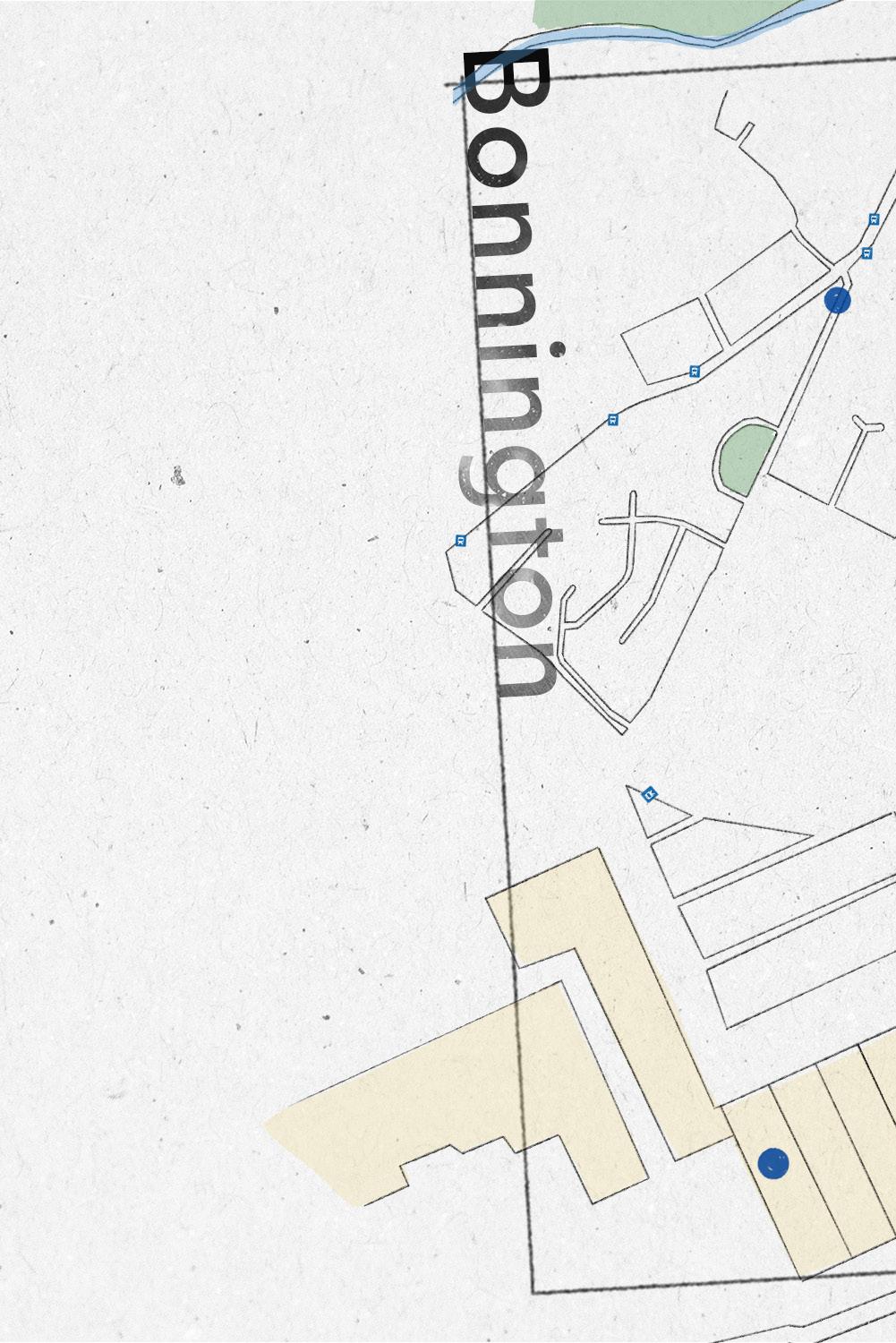
FABRIC FOCUS
Reaching 131 East Claremont Street, we are facing the glass door of Fabric Focus. The shop first opened its doors in 2014, focusing primarily on dressmaking and patchwork fabrics. Since then, however, new ranges have been included. Nowadays, it is a place where those who share a passion for color, texture, and pattern can indulge while being in the company of like-minded people. By entering the shop, one can easily spot the significant variety of fabric choices available. The place could easily be considered a prime center for sewers.
For our last location, we chose a rather interesting part of the Scottish capital and its surroundings. It could probably more correctly be described as a suburb of Edinburgh. A frequent film set location, the area is a picturesque corner, where, although so close to the hustle and bustle of the capital, tranquility seems to stretch over Newcraighall like a veil.
HOBBYCRAFT
Here is the home of the last stop on our DIY travel feature agenda — Hobbycraft . In comparison to the shops we visited in Edinburgh, our final destination is rather spacious, mostly looking like the wellknown retailers. Founded in 1995, Hobbycraft has since grown to a nationwide business with over 100 stores across the UK, ready to inspire an ever-expanding variety of crafts. With its different departments, the shop offers everything for art, knitting, and crochet, including haberdashery, and all needed for jewelry making. Once entering the shop, one can easily be inspired by the significant variety of all things crafty. Hobbycraft is a suitable stop for everyone passionate about crafts and do-it-yourself projects.





This concludes our DIY adventure. We hope you enjoyed our little trip through the neighborhoods of the Scottish capital and thank Shawna very much for her tips and beautiful photos. Her Instagram account @exploringedinburgh , by the way, is a constant source of impressions of the Scottish capital. It‘s well worth stopping by! We are already looking forward to our next destination! Maybe you can help us out and be our next city guide - just like Shawna Law. Do you live in a city we should explore with you? Then let us know and write to mail@sister-mag.com.



With our DIY tours we were already in London and Berlin. If you want to see the tours, just click on the right:






2. Trim your scraps: Unless you start with super neat edges, you will need to trim them. I always make sure both sides of the piece are parallel to each other. It makes planning and sewing much easier. It is of course possible to work with diagonal lines, too, but if you’re first starting out, making an orthogonal pattern will make your life easier. Don’t worry about the length of your scraps just yet, we will tackle that in the next step.


INSTRUCTIONS
1. What you need: Start with fabric scraps of your choice. I always choose the colors first, usually sticking to 4-5 hues, and making sure they have a nice contrast between them. I try not to mix light weight and heavy weight fabrics. The scraps in this tutorial are heavy weight cotton canvas pieces, colored with plant dyes. You’ll need a sewing machine, iron, roller cutter, scissors, a ruler to help you cut and a cutting mat. Before you start, cut out the final size you are aiming for from a piece of paper. You will need this pattern to plan your composition.
3. Arranging patches: I always start with arranging the scraps on the working table. It is an intuitive process, but there are a few things to keep in mind. Start with making small blocks, adding one piece at a time. This way you will make sure it is possible to sew them in this order, too. This pattern is made of four main blocks, each block made of 3-4 scraps in, each of them in different color, too. When putting the blocks together, try to make sure no scraps of the same color lie next to each other. I don’t cut the scraps just yet, but fold them to see how they work together. I can always unfold them
at this point and extend if I need to. Final tip - if working with a thick fabric like heavy weight canvas, never put more than three edges next to each other. Have a look at my composition - there is no spot where four scraps meet. It is a deliberate planning because otherwise the patching gets too bulky. When it you are happy with the composition, check if your cutout pattern is all covered. Leave at least a few centimeters on each side. The piece will get smaller when you sew the pieces together, so you need enough seam allowance. Better too much than too little!

4. Plan the sewing sequence: Now it’s time to cut the scraps. I use scissors and trim them roughly. I don’t mind if they are a few centimeters too long; they’ll get trimmed later. But you want to have a rough outline for your process. As you can see, my pattern consists of four main blocks, each of them made of 3-4 scraps. These four blocks will be connected at the very end - starting from the top middle and top right corner, then attaching the bottom block and finally adding the left block. But before that can happen, I need to sew the scraps within each block. As you might already see, for the top right
corner block, the sewing sequence will go as follows: sewing beige and peach, then adding dark grey, then adding moss green. I will use the same principle for all other blocks, adding one scrap at a time.
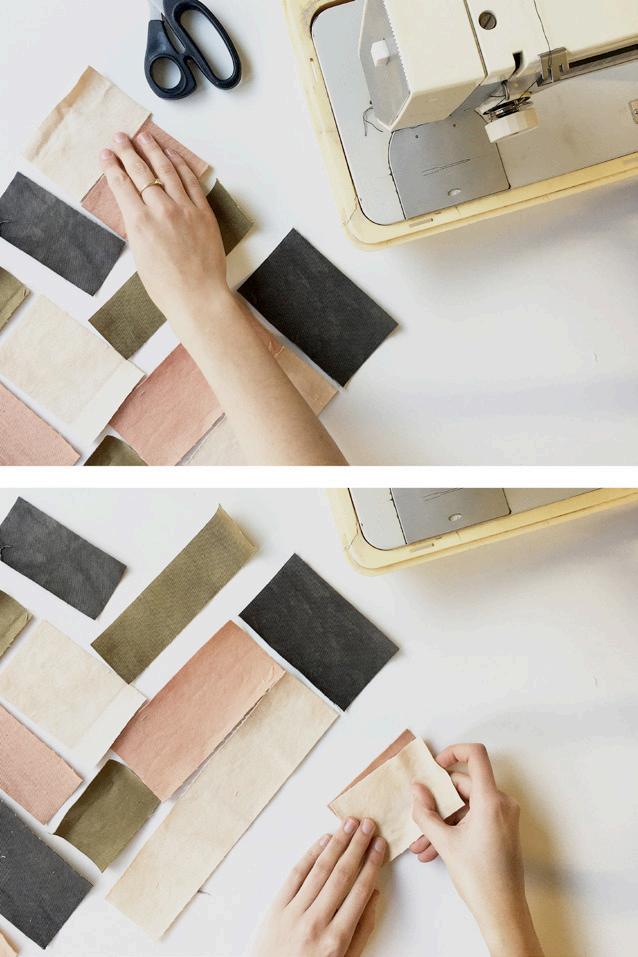
5. Start with the smallest block: I start with beige and peach. I know which sides will be connected as I planned it in advance. I put the pieces together - along the edge that will become a seam, right sides facing each other. A quick note here: I work on all four blocks simultaneously. I start with the smallest piece in each block and keep adding next scraps as I go.

6. Sew the pieces together: Sew ca. 0,5cm from the edge (0,25 inch). You don’t have to backstitch your seams, they will be held by the consecutive seams, as you keep adding next patches. Once you open your first small piece, you will notice it folds back together as soon as you release it. Don’t lose track of your composition and always keep it flat on the table.

7. Press the seams: In order to see the layout you need to press the seams flat open. I am pressing all four patches, each form one of the 4 main blocks. As said, I work on all blocks simultaneously, but you don’t have to do that. What you have to do, though, is to always press all seams as soon as you sew them. It is crucial step for adding next patches as you go, otherwise the pattern won’t sew properly and will look bulky once you finish.

9. Always add one patch at a time: I am adding the third fabric scrap to the two I sewed together before. The seams are now pressed down and lay flat. I always put the piece I am adding to the bottom, keeping the seams from the previous building block facing up. This way I can keep an eye on them and make sure they don’t fold as I sew. It is important to keep them flat with this next stitch. Just like before, the right sides are facing each other, and the wrong sides are turned to the outside.
8. Keep the pieces straight: First pieces are finished! Because my scraps were all different widths, I now trim them, so that they are straight again. I do that after each scrap I add.
10. Keep extending the blocks: Keep adding one piece at a time. The composition is now slowly growing. Remember to iron the seams after each round of stitching and keep the seams open when sewing consecutive scraps. Trim the pieces before sewing the next patch, to keep it flat and neat.



11. Many seams later… At this point all the four main blocks are made of 3 colors patched together. In two blocks the final scraps are still missing. Now I am adding the final scraps to the last two blocks. Once it’s done, I will press them again, trim, and start connecting the blocks into the fully patched piece.
12. Connect the main blocks: Just as planned at the very beginning, I connect the blocks in the following sequence: starting from the top middle and top right corner, then attaching the bottom block and finally adding the left hand block.


13. Finishing the patchwork: Looks like it’s done! I press the seams with an iron one last time. They all need to lay flat, so that the scraps don’t bulk in the front. This is how the right side should look like before you trim the piece for the last timenice and flat! Make sure all the seams are pressed well.
14. Troubleshooting: When I checked with my cutout pattern, it turned out the piece is too narrow. It happens a lot when I am working with small scraps, but it’s not a problem. I just take a color that was not yet added to the block I’m extending - moss green - and sew it to the edge.



15. Cut to the pattern: Once the piece is big enough and all seams are pressed, I cut it to the final size. I like using see-through tracing paper, so that I can position the seams away from the edges.

16. …and done! I made another piece for the other side of the bag, using the same colors. I chose matching fabric for the bottom of the bag and for the drawstring tunnel. Both sides are different but corresponding in colors.
17. Patchwork project bag: This is the final product – a plant dyed patchwork bag made with our production scraps. Completely unique and oneof-a-kind.

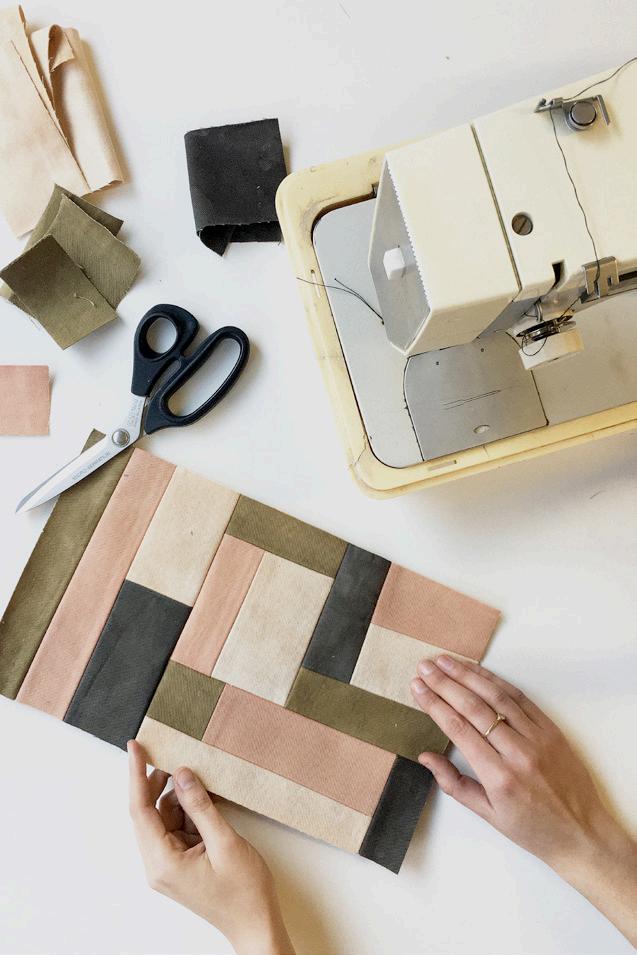

WalldecoPATCHWORK
Patchwork is one of the trendiest ideas, which found its place in interior design and home decoration.
The colorful technique inspired the fresh and easy DIY idea for a patchwork wall decoration.
 Photos : GABRIELA MORALES
Photos : GABRIELA MORALES
INSTRUCTIONS
MATERIAL
» Template printed on colored paper (the template is for an A2 format)
» Scissors
» Glue
» A2 frame
1. Print the template on A4 colored paper. With scissors, cut out the individual elements of the template.
2. Place the individual elements on the frame, as desired or with the pattern template, and glue. Ready!

PATCHWORK
BOOKS & RESSOURCES

PATCHWORK
Patchwork is one of the art forms that has been around for centuries. Sometimes traditional relaying on a grid of regular repeating designs or more modernusing asymmetry and unusual arrangements, the technique still brings the feeling of warmth that only handmade pieces can and have the power to do.
From home decorations to fashion items and accessories - patchwork is everywhere.
TO START AND LEARN
Quilt as You Go A practical guide to 14 inspiring techniques & projects by Carolyn Forster

Patchwork for Beginners


This guide offers beginners a practical approach to transforming inspiration into finished products.
by Sue PrichardModern Quilting
A contemporary guide to quilting by hand


by Julius Arthur @ houseofquinn
QUILTING
Urban Quilting
Quilt patterns for the modern-day home
 by
by
Wendy Chow @ the.weekendquilter
Improv Handbook for Modern Quilters

A guide to creating, quilting & living courageously
Modern Building Blocks
An encyclopedia of 40 modern quilt blocks and 6 inspiring projects
by Sherri Lynn Wood by Brigitte Heitland
MODERN
TECHNIQUES
Modern Machine Quilting Make a perfectly finished quilt on your home machine by Catherine Redford @ catherineredford

Walk
Master machine quilting with your walking foot by Jacquie Gering

The Encyclopedia of Quilting & Patchwork Techniques


A comprehensive visual guide to traditional and contemporary techniques
by Katharine Guerrier by Pauline Brown
Quilting Techniques
Essentials techniques and step-by-step projects for making beautiful quilts



SISTERMAG
www.sister-mag.com
Chief editor Theresa Wittemann, Antonia Sutter Operations Viktoria Todorova, Svala Wagner Fashion Eva-Maria Neubauer (Fashion Dir.) Design Marie Darme, Ilaria Trombí, Ezbah Ali, Alina Tahir, Svala Wagner Editors (Text) Dr. Michael Neubauer, Madison Jones, LaceyJo Hunter, Viktoria Todorova, sisterMAG Team
Contributing Editors (Foto & Video) Gabriela Morales, Cristopher Santos, Shawna Law
Translation & Proof Nadja Wieser, Alex Kords, Madison Jones, LaceyJo Hunter, Amie McCracken, sisterMAG Team
Published by Carry-On Publishing GmbH, Gustav-Meyer-Allee 25, 13355 Berlin, Germany. Re-Use of content is only allowed with written permission of the publisher. There is no liability for unsolicited manuscripts and photographs.
The Carry-On Publishing GmbH assumes no liability or guarantee for the accuracy, currency and completeness of the information provided. All information is provided without warranty. .
Contact : mail@sister-mag.com
Management Antonia Sutter, Theresa Wittemann, Alex Sutter Sales Alex Sutter (Sales Dir.) Marketing Antonia Sutter (Marketing Dir.)






























